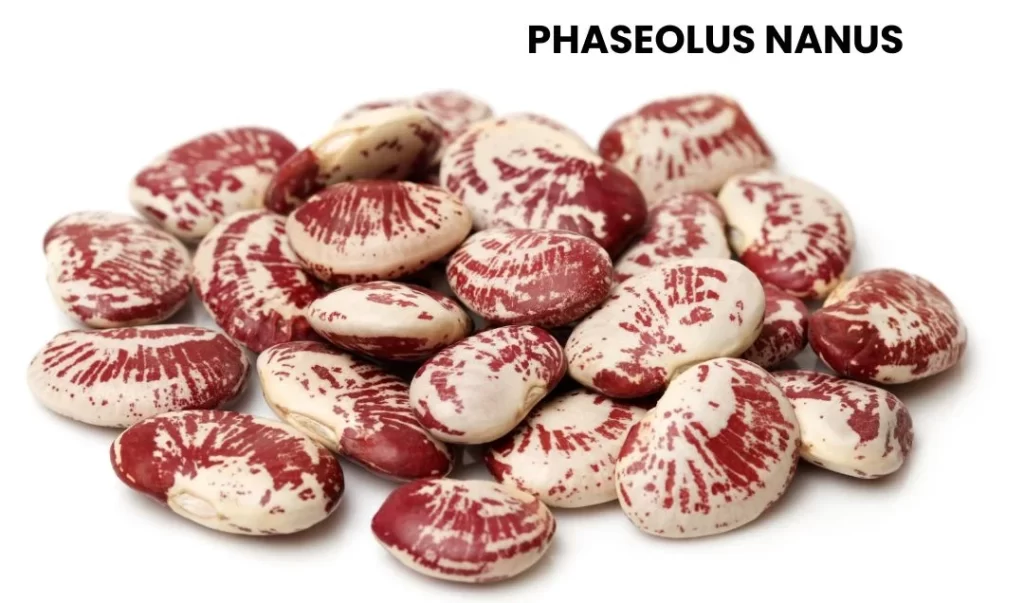Phaseolus Nanus, commonly known as Dwarf Bean, is a homeopathic remedy notable for its pronounced heart symptoms and its application in the treatment of diabetes.
This remedy is derived from the dwarf bean plant, which is widely cultivated for its edible seeds and pods.

SOURCE INFORMATION
Scientific Classification
- Kingdom: Plantae
- Order: Fabales
- Family: Fabaceae
- Genus: Phaseolus
- Species: Phaseolus vulgaris
Origin and Historical Facts
- Origin: The dwarf bean, Phaseolus vulgaris, is native to Central and South America.
- It has been cultivated for thousands of years and is now grown worldwide for its nutritional value.
- Historical Usage: Traditionally, beans have been used in various cultures not only as a food source but also for their medicinal properties.
- They were used to treat a range of ailments, including diabetes and heart conditions.
- The decoction of bean shells has been particularly noted in folk medicine for its potential benefits in managing diabetes.
DRUG PATHOGENESIS
- Phaseolus Nanus primarily affects the cardiovascular system and the urinary system.
- It is effective in alleviating heart symptoms such as palpitations, weak pulse, and feelings of impending doom.
- It also helps manage diabetic symptoms by influencing the composition of urine.
KEY CHARACTERISTICS
- Heart Symptoms: Notable for causing fearful palpitations, a weak pulse, and a sick feeling around the heart.
- There is often a sensation of impending death associated with these symptoms.
- Diabetes: The remedy is used to manage diabetic urine, indicating its potential in regulating blood sugar levels.
- Headaches: Causes headaches, primarily in the forehead or orbits, which worsen with movement or mental exertion.
DETAILED ORGAN SYMPTOMS
HEAD
- Aches: Chiefly in the forehead or orbits, worsened by movement or mental exertion.
EYES
- Pupils: Dilated and unresponsive to light.
- Pain: Eyeballs are painful to touch.
CHEST
- Breathing: Slow and sighing.
- Pulse: Rapid pulse and palpitations.
- Sickness: A sick feeling around the heart with a weak pulse.
- Soreness: Right ribs are sore.
- Dropsy: Dropsical effusion into the pleura or pericardium (fluid accumulation in the chest cavity or around the heart).
URINARY
- Diabetes: Manages diabetic urine, indicating its use in controlling diabetes.
HEART
- Palpitations: Fearful palpitations with a feeling that death is approaching.
MODALITIES
- Worse: Symptoms worsen with any movement or mental exertion.
WHAT ARE MODALITIES IN HOMOEOPATHY?
RELATIONSHIP WITH OTHER DRUGS
Compare
- Crataegus (Cratæg): Known for its efficacy in treating heart conditions.
- Lachesis (Lach.): Used for circulatory and heart-related symptoms.
DOSE
- Potency: Typically used in the sixth and higher potencies.
- Administration: A decoction of the shells can be used as a drink for diabetes, but caution is advised as it may cause severe headaches.
Frequently Asked Questions
What is Phaseolus Nanus used for?
- Phaseolus Nanus is primarily used for treating heart symptoms such as palpitations and weak pulse, and for managing diabetes, especially diabetic urine.
Is Phaseolus Nanus safe to use?
- When used in recommended homeopathic potencies, Phaseolus Nanus is generally safe for most individuals.
- It is advisable to consult with a qualified homeopathic practitioner for proper dosage and administration.
What are the side effects of Phaseolus Nanus?
- Side effects are rare when used in homeopathic potencies.
- However, using a decoction of the shells may cause severe headaches.
- Always consult with a homeopathic practitioner for proper guidance.
Glossary of Difficult Words
- Decoction: A method of extraction by boiling herbal or plant material to dissolve the chemicals.
- Palpitation: Noticeably rapid, strong, or irregular heartbeat.
- Diabetic Urine: Urine that is high in sugar, often found in people with diabetes.
- Dropsical Effusion: Accumulation of fluid in body tissues or cavities.
- Pleura: The membrane surrounding the lungs.
- Pericardium: The membrane enclosing the heart.
By understanding the detailed drug picture of Phaseolus Nanus, practitioners can make informed decisions regarding its use in treating heart-related symptoms and diabetes.
